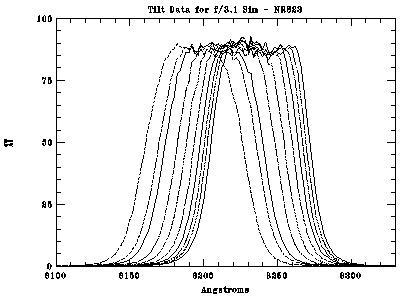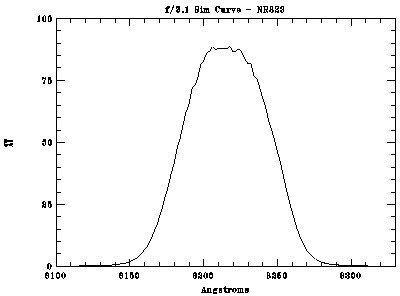Instructions for Fast Beam Simulations
Simulation of a Narrow Band Filter Response in a Fast Optical Beam
Narrow band interference filters (FWHM <=100 Angstroms) working in a fast beam normally have a blue-shifted transmission curve from that produced in a parallel or near-parallel beam. The amount of the wavelength shift can be as much as ~20A for the f/3.1 KPNO 4-Meter Prime Focus. Since the wavelength shift depends on the filter design, the thickness of the materials used and their index, there is no simple way to predict the blue-shifted profile. To simulate the response, George Jacoby has written a simulation program to calculate an estimated profile.
Data needed for a simulation:
- Telescope optical parameters: f-ratio to be simulated and the ratio of the diameters of the primary and secondary mirrors. For the 4-meter use f/3.1 and a mirror ratio of 0.4 .
- Ten passband scans of the filter at tilts of 0, 2, 3, 4, 5, 6, 7, 8, 9, and 10 degrees. The scans can be made on the NOAO Perkin-Elmer Lambda 9 Spectrophotometer using a special carrier for tilting the filter. The scans should be with a slit width of 0.2-0.5nm and a data sampling of 1-5 Angstroms and all the scans need to cover the exact same wavelength region. All raw data files from the Lambda 9 (.spa files) must be reduced with the RFD program on the Filter Lab computer. Note that the reduced data files are text files with no extension. Here is a sample of the family of curves at different tilt angles. The left-most curve is for a 10 degree tilt.

To run a sample simulation:
- Logon to gemini and cd to /ftp/pub/deveny/sample.
- Note the ten tilt data files NR823*D and the input file list NR823.tlt
- Run the program by typing "filt" using the file list NR823.tlt as input
Supply a name for the results file and compare it to the expected results in NR823sim.txt
Here is a plot of the final simulated profile.

To run your data:
- Logon to gemini and ftp your data files to /ftp/pub/deveny
- Create a data file list and run "filt".
Updated on May 7, 2021, 8:07 am